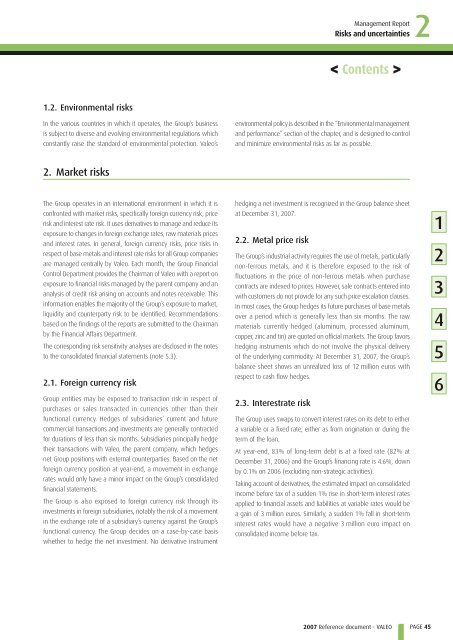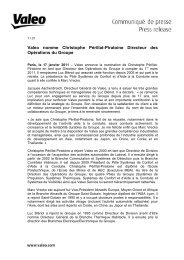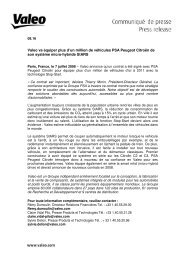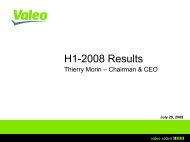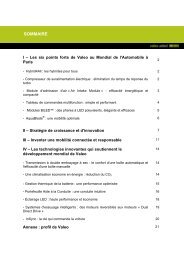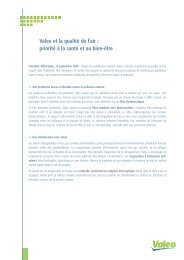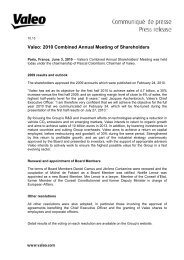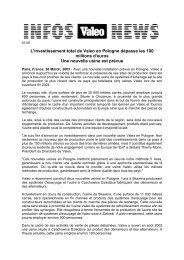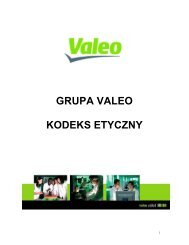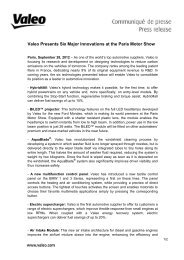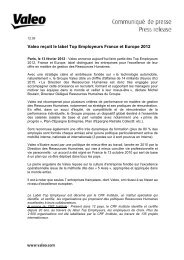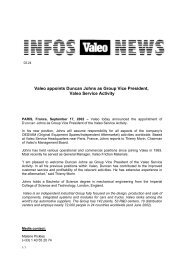2007 Reference document (PDF) - Valeo
2007 Reference document (PDF) - Valeo
2007 Reference document (PDF) - Valeo
Create successful ePaper yourself
Turn your PDF publications into a flip-book with our unique Google optimized e-Paper software.
1.2. Environmental risks<br />
In the various countries in which it operates, the Group’s business<br />
is subject to diverse and evolving environmental regulations which<br />
constantly raise the standard of environmental protection. <strong>Valeo</strong>’s<br />
2. Market risks<br />
The Group operates in an international environment in which it is<br />
confronted with market risks, specifically foreign currency risk, price<br />
risk and interest rate risk. It uses derivatives to manage and reduce its<br />
exposure to changes in foreign exchange rates, raw materials prices<br />
and interest rates. In general, foreign currency risks, price risks in<br />
respect of base metals and interest rate risks for all Group companies<br />
are managed centrally by <strong>Valeo</strong>. Each month, the Group Financial<br />
Control Department provides the Chairman of <strong>Valeo</strong> with a report on<br />
exposure to financial risks managed by the parent company and an<br />
analysis of credit risk arising on accounts and notes receivable. This<br />
information enables the majority of the Group’s exposure to market,<br />
liquidity and counterparty risk to be identified. Recommendations<br />
based on the findings of the reports are submitted to the Chairman<br />
by the Financial Affairs Department.<br />
The corresponding risk sensitivity analyses are disclosed in the notes<br />
to the consolidated financial statements (note 5.3).<br />
2.1. Foreign currency risk<br />
Group entities may be exposed to transaction risk in respect of<br />
purchases or sales transacted in currencies other than their<br />
functional currency. Hedges of subsidiaries’ current and future<br />
commercial transactions and investments are generally contracted<br />
for durations of less than six months. Subsidiaries principally hedge<br />
their transactions with <strong>Valeo</strong>, the parent company, which hedges<br />
net Group positions with external counterparties. Based on the net<br />
foreign currency position at year-end, a movement in exchange<br />
rates would only have a minor impact on the Group’s consolidated<br />
financial statements.<br />
The Group is also exposed to foreign currency risk through its<br />
investments in foreign subsidiaries, notably the risk of a movement<br />
in the exchange rate of a subsidiary’s currency against the Group’s<br />
functional currency. The Group decides on a case-by-case basis<br />
whether to hedge the net investment. No derivative instrument<br />
Management Report<br />
Risks and uncertainties<br />
environmental policy is described in the “Environmental management<br />
and performance” section of the chapter , and is designed to control<br />
and minimize environmental risks as far as possible.<br />
hedging a net investment is recognized in the Group balance sheet<br />
at December 31, <strong>2007</strong>.<br />
2.2. Metal price risk<br />
The Group’s industrial activity requires the use of metals, particularly<br />
non-ferrous metals, and it is therefore exposed to the risk of<br />
fluctuations in the price of non-ferrous metals when purchase<br />
contracts are indexed to prices. However, sale contracts entered into<br />
with customers do not provide for any such price escalation clauses.<br />
In most cases, the Group hedges its future purchases of base metals<br />
over a period which is generally less than six months. The raw<br />
materials currently hedged (aluminum, processed aluminum,<br />
copper, zinc and tin) are quoted on official markets. The Group favors<br />
hedging instruments which do not involve the physical delivery<br />
of the underlying commodity. At December 31, <strong>2007</strong>, the Group’s<br />
balance sheet shows an unrealized loss of 12 million euros with<br />
respect to cash flow hedges.<br />
2.3. Interestrate risk<br />
< Contents ><br />
The Group uses swaps to convert interest rates on its debt to either<br />
a variable or a fixed rate, either as from origination or during the<br />
term of the loan.<br />
At year-end, 83% of long-term debt is at a fixed rate (82% at<br />
December 31, 2006) and the Group’s financing rate is 4.6%, down<br />
by 0.1% on 2006 (excluding non-strategic activities).<br />
Taking account of derivatives, the estimated impact on consolidated<br />
income before tax of a sudden 1% rise in short-term interest rates<br />
applied to financial assets and liabilities at variable rates would be<br />
a gain of 3 million euros. Similarly, a sudden 1% fall in short-term<br />
interest rates would have a negative 3 million euro impact on<br />
consolidated income before tax.<br />
<strong>2007</strong> <strong>Reference</strong> <strong>document</strong> - VALEO<br />
2<br />
PAGE 45<br />
1<br />
2<br />
3<br />
4<br />
5<br />
6


